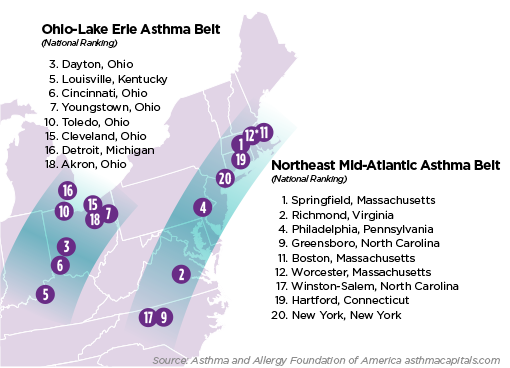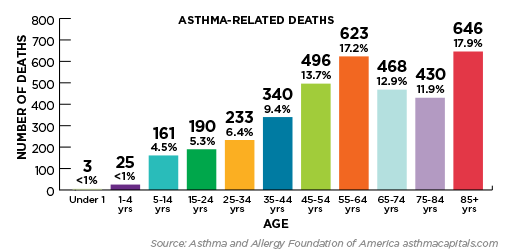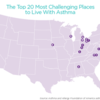More than 26 million Americans have asthma. There is no cure. But you can manage it with a proper treatment plan and by avoiding triggers. But there might be one thing out of your control that can make managing asthma a challenge: where you live.
Today, the Asthma and Allergy Foundation of America (AAFA) has released the 2018 Asthma Capitals™ report. This report ranks the top 100 cities in the U.S. where it’s challenging to live with asthma. We created this report to show how community factors can drive up asthma rates and how we need to all work together to decrease them.
We ranked each city based on these asthma outcomes:
- Asthma prevalence (or occurrence)
- Asthma-related emergency room visits
- Asthma-related deaths
Springfield, Massachusetts, is our #1 Asthma Capital for 2018. It has a high asthma rate overall. It also has the highest number of asthma-related emergency room visits in the U.S.
 Here are the top 20 Asthma Capitals:
Here are the top 20 Asthma Capitals:
- Springfield, Massachusetts
- Richmond, Virginia
- Dayton, Ohio
- Philadelphia, Pennsylvania
- Louisville, Kentucky
- Cincinnati, Ohio
- Youngstown, Ohio
- Birmingham, Alabama
- Greensboro, North Carolina
- Toledo, Ohio
- Boston, Massachusetts
- Worcester, Massachusetts*
- Omaha, Nebraska*
- Milwaukee, Wisconsin
- Cleveland, Ohio
- Detroit, Michigan
- Winston-Salem, North Carolina
- Akron, Ohio
- Hartford, Connecticut
- New York, New York
*Tie
“Asthma Belts”
This year’s report had an interesting result. We noticed that all of the top 20 Asthma Capitals are located in the eastern half of the U.S. But we also found two “Asthma Belts.” One is in the Ohio-Lake Erie area. The other is on the Northeastern Mid-Atlantic coast. In our report, we look at factors that affect residents in these belts, like poverty, air quality and pollen.

Personal Stories
Asthma can have a physical, emotional and financial toll on those with asthma and their caregivers. We interviewed six residents from some of our top asthma capitals about how where they live affects how they manage their asthma. During National Asthma and Allergy Awareness Month, which starts today, we will post these stories on our blog.
![]() There’s times when I don’t know how I manage. It gets very stressful, especially since it’s not something acute where a child is really sick and then gets better. You have to be on top of that medical care all the time.” – Nancy Gomez of Boston, Massachusetts, about managing her son’s asthma care
There’s times when I don’t know how I manage. It gets very stressful, especially since it’s not something acute where a child is really sick and then gets better. You have to be on top of that medical care all the time.” – Nancy Gomez of Boston, Massachusetts, about managing her son’s asthma care
Reducing Rates
Each day, 10 people die from asthma. That’s 10 too many. The 2018 Asthma Capitals™ report shows that we can all play a role in saving lives by improving our communities. We hope this report will drive the conversation about how local, state and federal leaders can improve their communities to make life better for those with asthma.
“Warmer temperatures from climate change are increasing ground-level ozone levels, especially in more urban, industrialized areas,” says Kenneth Mendez, President and CEO of AAFA. “This, combined with a lack of policies to protect those with asthma living in poorly maintained rental housing and inadequate health care, creates a perfect storm of asthma prevalence. We’ve seen ways communities can make changes to help asthma patients. This report shows us where we can focus to provide solutions to improve the health and quality of life in urban areas for asthma patients.”
Learn More About the Report
The Asthma Capitals™ ranking is an annual research and educational project of AAFA, designed to help patients recognize, prevent and manage asthma symptoms. Through this ranking, AAFA raises awareness about the impact of asthma and highlights how communities can make improvements to better serve their residents and visitors with asthma. The ranking is based on asthma prevalence, emergency room visits and mortality rates. The report also looks at risk factors, including poverty, air quality and access to specialists. Visit AsthmaCapitals.com to see the full list of 100 cities, methodology and to learn more about asthma management.
To see the full list of Top 100 Asthma Capitals, download our report.
The 2018 Asthma Capitals report is an independent research project of AAFA made possible by Sanofi Genzyme and Regeneron.




Comments (2)